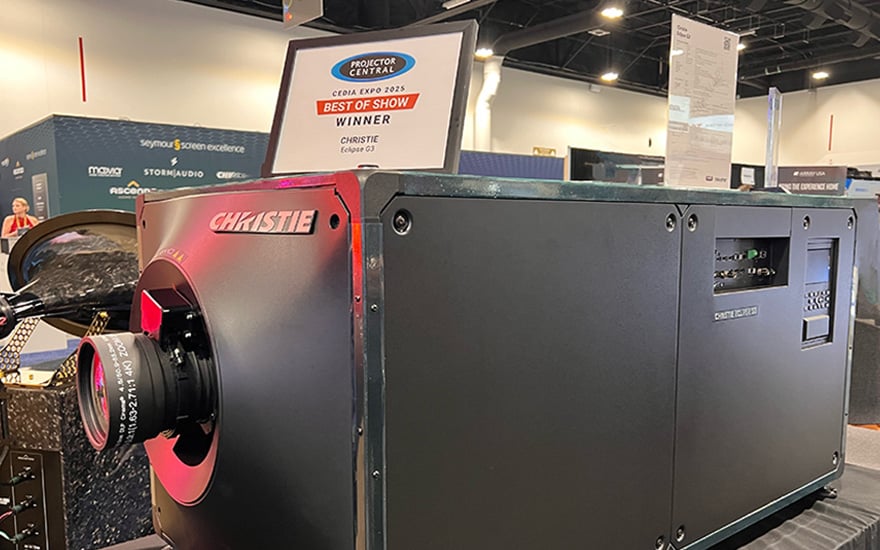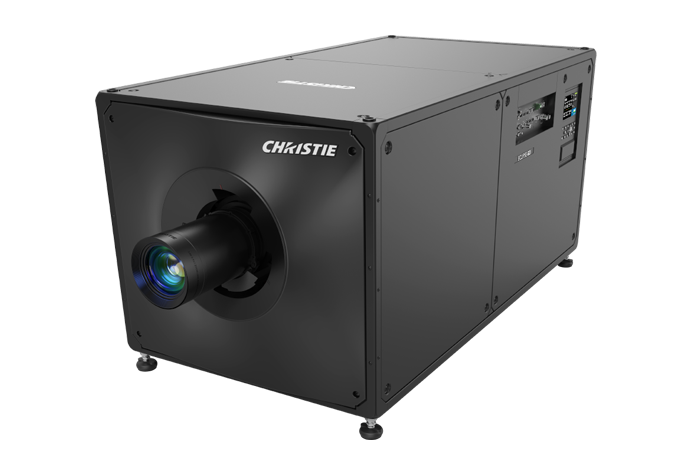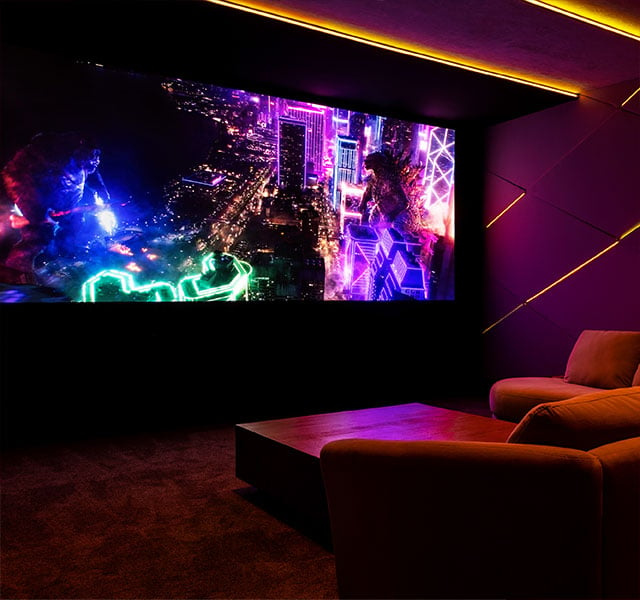We speak with product manager Larry Paul to learn more about our new 6DLP RGB pure laser projector
30,000 lumens. True HDR. Native 4K. 6DLP. RGB pure laser.
To say that Eclipse G3 is in a class of its own is an understatement. It certainly made an impression at CEDIA Expo 2025. It debuted in SR7 as part of a USD$1.3 million luxury home theater demonstration, and ProjectorCental and CE Pro named it a “best of show” winner.
We wanted to learn more about Eclipse G3. Larry Paul, executive director, Technology and Custom Solutions, spoke with us about the evolution of Eclipse technology, what makes Eclipse G3 unique, and the guiding principle that our engineering team used when creating this projector.
Read the Q&A
Q: Could you start by giving us an overview of Eclipse G3?
Larry Paul (LP): Christie Eclipse G3, or Gen.3, is our third generation of Christie Eclipse technology. We've incorporated all the learning and experience we've had with our Gen. 1 and Gen. 2 products, and over 13 years of delivery of RGB pure laser illumination into the new projector.
The performance is like the previous generations, up to 20,000,000:1 sequential contrast ratio for the blackest blacks and the brightest brights, but now in a new form factor. With Eclipse G3, we’ve simplified and streamlined how the light gets from the light source into the projector by moving light source into the projector head.
We’ve also removed the majority of the heat and noise from the projector head and put that where the chiller is. The chiller can be in a separate room to keep the noise and heat separate from the projector. The projector itself is actually very quiet, typically under 45 decibels.
Q: Let’s talk about the light source, since it’s one of the biggest differences in the new Eclipse G3 from previous generations. Could you explain what’s new?
LP: In previous generations of Eclipse, we had a remote laser source. In the first generation, we had a big, tall laser rack that drove the lasers through fiber into the projector head. The second generation had both an external laser rack and an external chiller, making it a three-part system. And again, the fiber carried the light from the laser rack to the projector head by making the chassis a little bit longer, shorter, and narrower. Now, we’ve taken those lasers and packaged them directly into Eclipse G3 so it’s two-part system. It's eliminated a lot of the complexity that has gone into making that illumination work.
Fiber coupling is still a great way to do things, but bringing the lasers into the projector makes G3 a simpler, straightforward product from a stability and reliability standpoint. It also simplifies the setup.
Watch the video to learn more about Eclipse G3
Watch Youthman's in-depth look at Eclipse G3 and other Christie AV solutions at CEDIA 2025
Q: Technology has certainly evolved from the first generation to Eclipse G3. What else has changed?
LP: With Eclipse G3 we can maintain 100% brightness for 50,000 hours without degradation. We've used our latest laser technologies, and we put a little bit more overhead in the projector, so we can run it at full power and maintain that full power for 50,000 hours.
Q: Could you tell us what it means to say that Eclipse G3 makes “video black” a thing of the past?
LP: On a standard digital projector with a light source that turns on, like lamp, laser, or laser phosphor, when the illumination source comes on, it illuminates the entire area of the chip. So, it illuminates everything, not just the pixels you want. This creates a grey overcast – also known as “video black”.
With Christie Eclipse G3’s unique 6DLP design, we've created a solution where black is truly black. One pixel can be 20 million times brighter than the pixel beside it.
Q: Is that what is referred to as sequential contrast?
LP: Correct. Some projectors claim millions to 1 contrast, but they do that by turning the light source off. And by turning the light source off, it's black, but as soon as you have one pixel that's illuminated on the screen, you have to turn on the entire array of pixels.
With Eclipse G3 that is not what happens. You can actually have one dot that is 20 million times brighter than the black surrounding it. So black is truly black, and you get this incredible contrast ratio, enabling the best-looking image possible.
Q: HDR is a term that is used a lot. Could you explain how this projector reproduces true HDR content?
LP: HDR is one of those industry buzzwords that says a lot, but it doesn't have a specific definition; however, HDR10 is a specification. HDR10 means that the projector can decode an HDR10 signal, though it doesn't mean it can reproduce the full range of contrast that a HDR10 signal can provide.
You might read or hear something like, “We're HDR compatible.” Well, that doesn't mean it's true HDR. True HDR is when you get incredibly bright whites and dark blacks, which enables specular highlights for depth and realism, and fine details to really pop.
Q: We recently showed the Eclipse G3 at CEDIA Expo 2025, and we had amazing feedback from everybody who saw it. How does Eclipse G3 deliver this highly immersive experience?
LP: It's because of the contrast ratio. We can create levels of detail where objects seem like they're almost floating off the screen because of the black surrounding them.
The feedback we had from Sound Room 7 was just over-the-top excitement.
Q: How important is the complete room design to the performance of Eclipse G3?
LP: Everything contributes to the performance of the room! Obviously, you don’t want any windows or any light coming into the room, or any white walls or seats. This reflects light around the room and can wash out the contrast on the screen. So the darker you can make the room – the treatments, the walls, the floors, the carpets– will make a big difference to the overall experience.
You can really see Eclipse G3’s full capabilities in a fully dark environment with the right screen, which is what we demonstrated in SR7 at CEDIA Expo.
Q: Could you elaborate on the screen, and screen gain, with Eclipse G3?
LP: Generally, the lower the gain of the screen, the higher the contrast appears to be. Now the blacker you make the screen, the more power you need from the projector to get the contrast to pop.
One of the advantages of Christie Eclipse G3 is that we have up to 30,000 lumens to play with, unlike many other home theater projectors that are in the 2-5,000 lumen range. Eclipse G3 has a lot more headroom to get illumination onto the screen, and this means a wider choice of screen materials.
With Eclipse G3, there’s exceptional flexibility for the technicians who are designing and calibrating a system.
Q: Speaking of calibration, do you recommend using a tone mapping device with Eclipse G3?
LP: When Eclipse is installed in fixed environments, like a planetarium or theme park, the content is typically mastered for the projector, and no additional device is required. However, with content that is shown in a home theater, our qualified integrators will always install a tone mapping product (from madVR or Lumagen) to get the best image regardless of the content that is feeding the projector.
For this reason, the Eclipse G3 is only available from select and highly qualified distributors for the home theater market. They have the required experience, skills, and tools to calibrate the entire projection system as part of a full system solution.
Q: Is there anything else you’d like to add?
LP: The goal with Eclipse, now in its third generation with the Eclipse G3, has always been to deliver the best possible on-screen image for home theaters, planetariums, and media-based attractions, with the ultimate in contrast and color volume.


